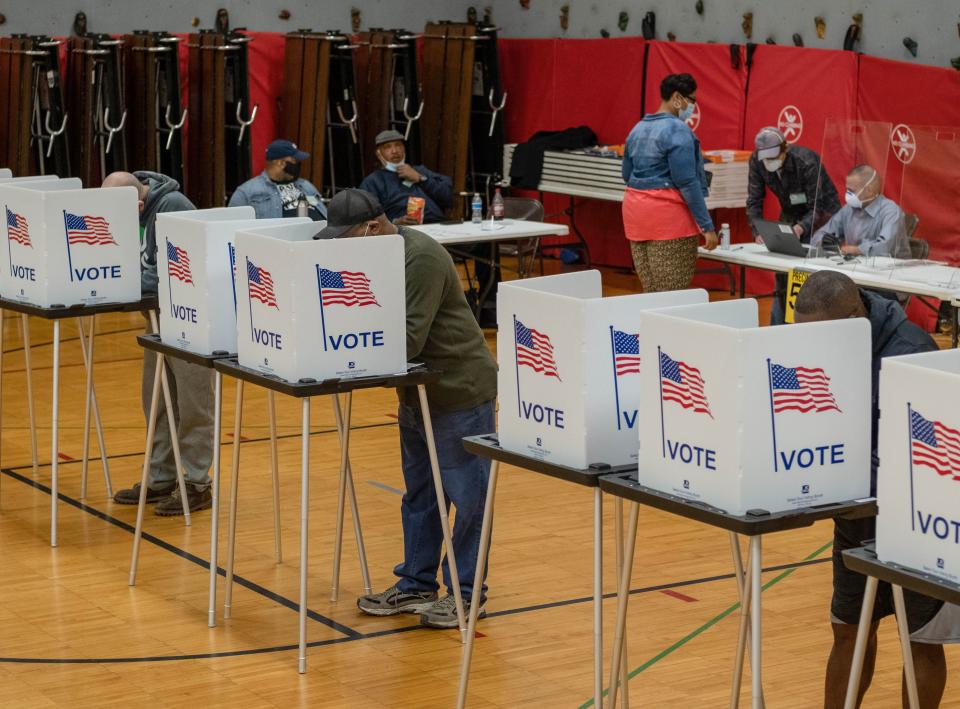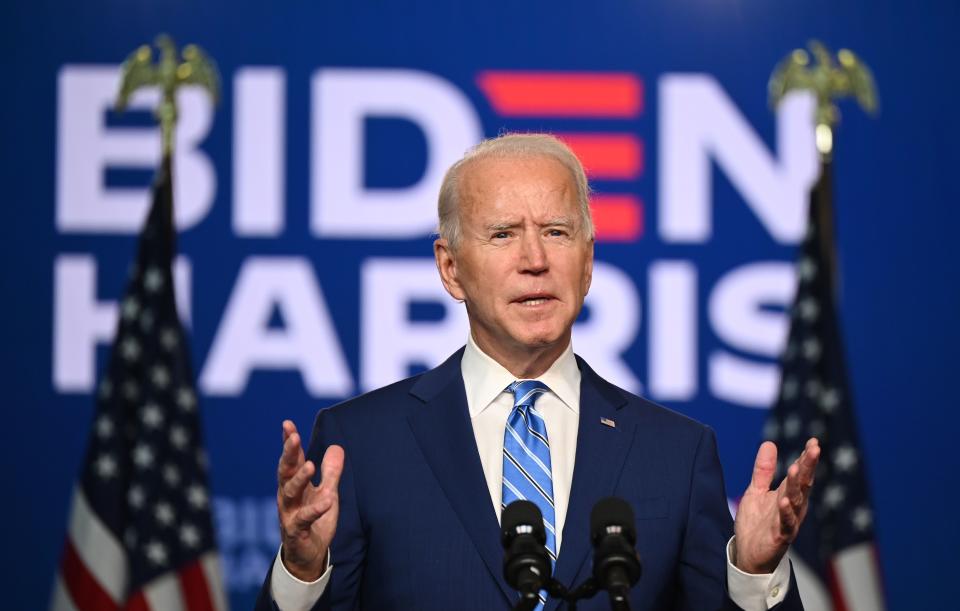Why the polls were wrong about Trump (again)
As of Wednesday afternoon, we still don’t know for sure who the next U.S. president will be. That’s because — as expected — key states such as Michigan, Pennsylvania, Nevada, Arizona and Georgia haven’t finished counting their votes.
But one thing is clear, even now: Pollsters systematically underestimated President Trump’s support — again. This time, they missed by an even bigger margin than in 2016. And Yahoo News was no exception; our final YouGov poll gave Democrat Joe Biden a 10-point lead.
And so even if Trump doesn’t beat Biden, he has largely beaten his pre-election polls.
The question is why almost everyone was off.
The 2020 polling error “matches the pattern of the 2016 error really well, so there really does seem to be something wrong here,” explained G. Elliott Morris, a data journalist who runs the Economist’s election forecast, during a Wednesday postmortem on the “Science of Politics” podcast. “It’s not just two random polling errors.”

Across the Rust Belt in particular, the polls and the results weren’t even close:
In Michigan, this year’s final FiveThirtyEight polling average (the most comprehensive and careful in the field) showed Biden ahead by 7.9 percentage points. The race is now on track to be decided by less than 2 points. Four years ago, Hillary Clinton led by an average of about 4 points in Michigan heading into Election Day. She lost by one-quarter of a point. That means this year’s Michigan polls were off by 6 or 7 points — and less accurate than 2016’s by something like 2 or 3.
In Wisconsin, this year’s final polling average showed Biden ahead by 8.4 percentage points. He is now on track to win by less than 1 point. Four years ago, Clinton led by an average of about 5 points in Wisconsin heading into Election Day. She lost to Trump by less than a point. That means this year’s Wisconsin polls were off by as much as 8 points — and less accurate than 2016’s by about 2.
In Ohio, this year’s final polling average showed Trump ahead by 0.8 percentage points. He is now on track to win by 8. Four years ago, Trump led by an average of 2 points in Ohio heading into Election Day. He won by 8. That means this year’s Ohio polls were off by about 7 points — and less accurate than 2016’s by about 1.
And in Iowa, this year’s final FiveThirtyEight polling average showed Trump ahead by 1.3 points. He is now on track to win by about 7. Four years ago, Trump led by an average of 3.4 points in Iowa heading into Election Day. He won by 9. That means this year’s Iowa polls were off by nearly 6 points — and just as inaccurate as 2016’s.
The list goes on.

In Florida, Biden led in the final polling average by 2.5 points; it looks like he is going to lose by about 3.5, for a 6-point polling miss.
In Nevada, Biden led in the final polling average by 5.3 points; it looks like the results will be extremely close, for a roughly 5-point polling miss.
In Texas, Trump led by 1.1 points in the final polling average; it looks like he is going to win by 6, for another 5-point polling miss.
In Pennsylvania, Biden led in the final polling average by 4.7 points; that will probably prove to be off by a few points once all the votes are tallied.
Even the national polls appear to have missed the mark this time around. In 2016, Clinton led by 3 to 4 points in the final polling average, depending on which average you consulted. She wound up winning the national popular vote by 2.1 points, so the polls back then weren’t that far off.
In 2020, however, the final FiveThirtyEight national polling average showed Biden ahead by a lot more than Clinton: 8.4 points. Like his Democratic predecessor, the former vice president will win the popular vote once big blue states such as California, New York, New Jersey, Maryland, Massachusetts and Illinois finish counting more than 10 million outstanding ballots. One estimate has Biden, who is currently leading by 3 million votes, winning by roughly 5 million to 7 million — about twice Clinton’s 2016 margin.

But in light of this year’s historic turnout on both sides, that would equal a gap of just 3 to 5 percentage points. In other words, the national polls may have missed this year by about twice as much as in 2016, if the estimates hold.
Yahoo News was among the media organizations whose national numbers likely overstated Biden’s advantage. We partnered with YouGov early this cycle and asked it to conduct regular national opinion surveys about politics, coronavirus and the news of the week on our behalf. In those polls, the smallest lead YouGov ever found for Biden was 5 points. YouGov’s final Yahoo News survey showed Biden leading Trump 53 percent to 43 percent.
At the time, we wrote that a 10-point Biden victory “is hardly assured. But given the size and stability of Biden’s national lead, the scope of his competitiveness in key states and the staggering number of Americans who have already voted … the president will secure a second term only if polls are underestimating his support by far more than in 2016, when they missed by about 1 point nationally and about 4 points in Michigan, Wisconsin and Pennsylvania.”
That turned out to be exactly what happened on Election Day — aside from the part about Trump securing a second term, for which he faces an uphill battle in the Electoral College. As a result of similar errors, Democrats are also coming up short in more Senate and House races than expected.
Regardless of who wins the White House, talk will turn in the days ahead to why 2020’s polling was even more wrong than 2016’s. Right now, the answer is “we don’t know.”
Polling errors are commonplace; they happen in most elections. But they tend to be random and to change directions from one cycle to another. Sure, in 2016 the swing-state polls underestimated Trump by 4 points or so. But four years earlier, in 2012, they underestimated Barack Obama by about the same amount.

One reason this happens is that pollsters are always adjusting their methodologies to avoid making the same mistake twice. From 2016 to 2020, this was supposed to ensure that white voters without college degrees — a hard-to-reach but disproportionately pro-Trump demographic — would be better represented in their surveys. The shortfall was supposed to be fixed.
But the troubling thing about 2020 is not just that the polls missed again. It’s that they missed again in the exact same places they missed in 2016 — and they missed by even more. This suggests that whatever went awry in 2016 has only worsened over the last four years, and that “weighting for education” or other methodological tweaks can’t correct for it.
Instead, the problems causing pollsters to increasingly understate Trump’s support are probably more profound than that. The polls were very accurate in 2018, when Trump wasn’t on the ballot, and certainly in states, such as Arizona, it seems that pollsters are actually underestimating Democrats.
But those are the exceptions that prove the rule. For two elections in a row now, Trump has drawn on unanticipated wells of support to perform better on Election Day than the polls predicted — and despite the best efforts of the best pollsters in the business to get better at measuring his vote, they seem to have gotten less accurate, not more.
It’s going to take time to identify the cause — or more likely, causes — of this stumble. Early theories abound. During Wednesday’s “Science of Politics” postmortem, Morris and host Matt Grossman, a political scientist at Michigan State, considered several possibilities.
In south Florida, pollsters failed to catch a huge Trump-ward shift among Cuban Americans that largely accounted for the president’s statewide victory; Hispanic districts in South Texas also swung heavily toward Trump.
In the Northern battlegrounds, meanwhile, surveys seem to have correctly pegged Biden’s improvement with white, college-educated suburban voters — but greatly overestimated the Democrat’s inroads among the white, non-college voters who surprised pollsters in 2016.

Researchers have largely ruled out the idea of “shy Trump voters” who lie to pollsters and say they’re undecided or that they favor someone else when they really favor Trump. But it’s possible, Grossman and Morris speculated, that pro-Trump, non-college-educated whites are simply less inclined to pick up the phone or participate in polls than pro-Biden, non-college-educated whites.
Why? Because the pro-Trump cohort also tends to have less “social trust” — i.e., less “trust in other people or institutions,” as Morris put it. Spurred by Trump’s “fake news” mantra, participating in polls may have itself become politicized. When overall response rates are as low as 4 percent, this could skew the results against Trump in places like the Rust Belt or Texas.
A similar dynamic may have also made it seem like more Republicans were flipping from Trump to Biden than ultimately did — again, because pro-Trump Republicans may be less inclined than pro-Biden Republicans to answer a pollster’s call or participate in an online survey.
Other potential reasons for 2020’s big miss may have been beyond anyone’s control. It’s unlikely that late-breaking voters who decided within the last week made the difference, even though they told exit pollsters they favored Trump over Biden by 14 percentage points. There simply weren’t enough of them this year — just 4 to 5 percent of the overall electorate vs. about 14 percent in 2016 — to explain Trump’s overperformance on Election Day.
A more plausible scenario, Morris said, is that a significant number of pandemic-induced mail ballots are either arriving late, or being rejected, or not being returned at all. If tons of people tell pollsters they’ve voted by mail and then, for whatever reason, some those “likely votes” don’t actually count on Election Day, it could widen the gap between the polls and the results.
Political scientists and pollsters will debate these problems for years to come, and they’ll probably devise new approaches to deal with them. But after being told that Joe Biden could win in a landslide — and then watching as Trump beat his polls by even more than 2016 in state after state — the broader public might be more inclined to dismiss political surveys in the future.
There are “systematic problems that they haven’t solved since 2016, and in fact seem to be worse this time,” Morris said. “That’s pretty troubling if you’re a pollster — especially if you’ve spent the last four years trying to reckon with the fact that polls were missing Trump supporters. So they have a big reckoning ahead of them.”
_____
Read more from Yahoo News:

 Yahoo News
Yahoo News 


